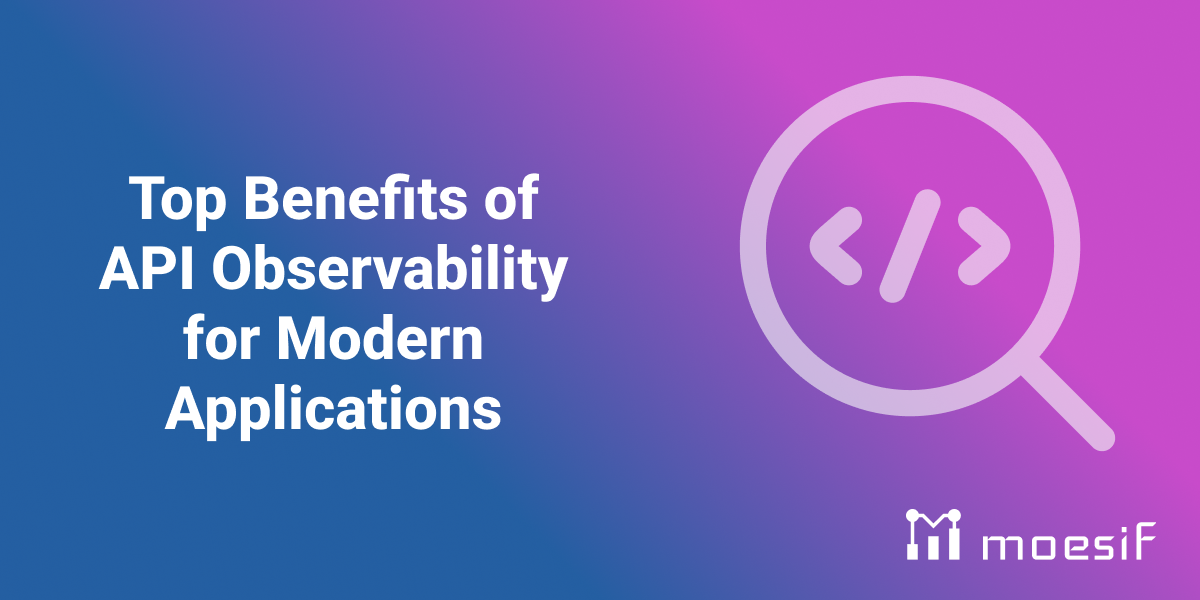Top Benefits of API Observability for Modern Applications

API observability is essential for enhancing performance, speeding up issue resolution, and tightening security. An API observability tool is crucial for understanding and managing the complex web of API interactions within modern enterprise applications. With the benefits of API observability, you can dive deep into API behavior, ensuring reliability and better user experiences.
In today’s digital landscape, where APIs act as the backbone of many applications, having robust observability is more critical than ever. It allows organizations to monitor, debug, and improve their APIs continuously. This proactive approach not only minimizes downtime but also enhances the overall efficiency of the API ecosystem. By leveraging advanced observability tools, businesses can gain actionable insights into API performance metrics, identify potential bottlenecks before they escalate, and ensure seamless integration between various services.
API observability fosters a culture of collaboration among development, operations, and security teams. By providing a unified view of system health and performance, it enables cross-functional teams to work together more effectively, ensuring that APIs are not only high-performing but also secure and compliant with industry standards. This holistic approach to API management ultimately drives innovation and supports the achievement of broader business objectives.
Key Takeaways
- API observability improves performance by identifying bottlenecks, optimizing resource allocation, and ensuring smooth running, giving developers the visibility to predict and prevent issues.
- Observability tools speed up issue resolution with real-time error detection, root cause analysis, and reduced downtime, so you can identify and fix issues in API-driven applications quickly.
- Strengthening API security with observability means anomaly detection, data breach prevention, and compliance monitoring, so you have secure, compliant API environments that protect sensitive data and user trust.

Enhancing API Performance
API observability is a total game changer in software development. By giving you a full view of API performance and user experience, observability tools let you understand, manage, and optimize your APIs for performance. This goes beyond traditional API monitoring, giving you request flow, transaction traces, and logs to troubleshoot complex issues and continuous improvement and scalability in API-driven applications. With an observability tool and API management, you can ensure your APIs run smoothly and improve the overall user experience by drilling into the API’s performance and providing insights into the API’s performance and usage patterns.
The building blocks of API observability, structured logs, metrics, and traces let you predict and prevent issues so your APIs can do their job efficiently and reliably. By looking at API data and monitoring API calls you can proactively identify expected and unexpected issues and have a smoother operation and better user experience.
The following sections will go into more detail on API performance, identifying bottlenecks, optimizing resource allocation, and monitoring API performance.
Identifying Performance Bottlenecks
Pinpointing the main source of performance problems in modern API applications can be challenging due to the increasing complexity of these systems. Traditional monitoring tools often fall short, but API observability tools, with their ability to track API requests from start to finish, provide a clear picture of where delays occur. Distributed tracing, a key feature of observability, visualizes the journey of a request through various services, helping identify bottlenecks and inefficiencies.
By representing the lifecycle of a request as it travels through different components, traces help developers follow the request’s journey and pinpoint delays caused by components outside of direct control, such as network errors. This detailed sequence of events within an API request is invaluable for optimizing performance and ensuring that APIs perform at their best.
Optimizing Resource Allocation
Optimizing resource allocation is a crucial aspect of maintaining high API performance. API observability enables better resource management by analyzing high-cardinality data, which helps identify the busiest API endpoints and allocate resources accordingly. Insights gained from this analysis provide information on how to allocate resources more effectively, ensuring that APIs perform optimally under varying loads.
Distributed tracing further aids in visualizing the complete journey of a request, helping to optimize resource allocation in microservices architectures.
Ensuring Smooth Operation
Running your APIs smoothly means continuous monitoring and predictive issue detection. By detecting issues early continuous monitoring prevents issues and ensures information delivery is reliable. Enhanced observability reduces downtime by giving you fast response times and real-time analytics which gives you instant insight into API performance and allows you to make quick decisions. Continuous monitoring also helps you track performance benchmarks and drill into the API’s performance.
Centralized dashboards in observability tools like Prometheus and Grafana give you real-time data visualization so you can stay informed and react to issues as soon as they happen. Telemetry data from observability tools also lets DevOps and site reliability engineers see the internal state of the API so they can make better decisions and run smoothly.
Accelerating Problem Resolution
In the fast-paced world of API-driven applications, the ability to quickly resolve problems is crucial. API observability tools provide detailed insights into errors, allowing teams to:
- View real-time data
- Spot issues as they happen
- Facilitate swift resolutions By correlating logs, traces, and metrics, these tools enable rapid root cause analysis, reducing the time needed to identify and resolve problems.
Advanced observability tools can even predict potential issues before they escalate, further reducing downtime and ensuring a reliable API ecosystem. The following subsections will explore the specific benefits of real-time error detection, root cause analysis, and reduced downtime in more detail.
Real-Time Error Detection
Real-time error detection is a key part of API observability so you can identify and resolve issues immediately. Observability tools give you immediate alerts for performance deviations so you can take a closer look and fix them fast.
By giving you real-time data visualization and alerting these tools simplify the communication of issues and system status so errors are detected before customers report them.
Root Cause Analysis
Root cause analysis in API observability streamlines troubleshooting by correlating different data points and events to pinpoint exact issues. Automated root cause identification leverages structured logging to quickly address API problems, facilitating effective problem-solving.
Observability tools can trace system changes, such as delays, by examining various factors like database queries or new code deployments, providing detailed insights needed for accurate root cause analysis.
Reduced Downtime
Reduced downtime is achieved through:
- Proactive issue detection
- Quick resolution of issues
- Real-time error detection
- Addressing issues the moment they are identified
- Using historical data to alert teams of potential future problems
- Allowing for quick rollbacks or disabling features to minimize service interruptions
This approach ensures a seamless user experience and optimal performance.
Strengthening API Security
API security is paramount in modern software development, and observability plays a crucial role in strengthening it. By monitoring abnormal API usage patterns in real-time and utilizing predictive algorithms, observability tools can detect security threats and forecast potential breaches before they occur. This proactive approach ensures a secure and compliant API environment, protecting sensitive data and maintaining user trust, while also contributing to overall API health.
Improved observability enables continuous monitoring of API access and usage, using logs and traces to track user behavior and identify potential unauthorized access attempts. This also strengthens compliance by ensuring a proactive approach to monitoring and addressing any irregularities. The following subsections will delve into specific aspects of strengthening API security, such as anomaly detection, preventing data breaches, and compliance monitoring.
Anomaly Detection
Anomaly detection in API observability identifies unusual patterns that may signal security threats. Through continuous monitoring, observability tools provide a holistic view of system performance, helping in early detection of anomalies.
Advanced anomaly detection tools use machine learning algorithms to identify and flag unusual API behavior, ensuring that potential security issues are addressed promptly.
Preventing Data Breaches
Preventing data breaches is a critical aspect of API security. Continuous monitoring plays a vital role in early detection of potential security threats, allowing for quick identification of unauthorized access attempts.
By continuously analyzing log data and monitoring APIs, observability tools facilitate the early detection of data leaks, significantly reducing the risk of data breaches.
Compliance Monitoring
Compliance monitoring ensures adherence to regulatory requirements by tracking API access and usage. Observability platforms facilitate compliance by logging and analyzing API interactions, providing real-time compliance reports.
This continuous monitoring helps ensure that APIs meet regulatory requirements consistently, maintaining a secure and compliant API environment.
Improving User Experience

Improving user experience is a key goal of API observability. By understanding user behavior and tailoring API responses to meet user needs, observability tools enhance user satisfaction and engagement. Analyzing API usage patterns can highlight parts of the user journey that may be causing frustration or high drop-off rates, allowing for targeted improvements.
Additionally, API observability helps identify potential issues impacting user experience before they become actual problems, ensuring a seamless interaction with applications. The following subsections will explore how understanding user behavior, tailoring API responses, and enhancing reliability contribute to improving user experience.
Understanding User Behavior
Understanding user behavior through observability data helps you tailor APIs to user needs. By analyzing logs and metrics observability tools give you insights into how users interact with APIs, and what usage patterns and features they prefer.
API logs + user behavior tracking gives you a complete view of user interactions so you can see usage patterns and preferences.
Tailoring API Responses
Tailoring API responses based on user preferences and contextual data enhances relevance and personalization. Observability data helps in understanding user preferences, enabling the customization of API responses to deliver more relevant and personalized content or actions.
This approach leverages contextual data to offer a more relevant user experience.
Enhancing Reliability
Reliability through consistent API performance means smooth user interaction with applications. Observability tools contribute to higher system reliability by fixing issues before they cause extended downtime.
By giving you a complete view of how software components work together observability means users experience minimal downtime.
Supporting Business Goals
Supporting business goals with API observability means making informed decisions, optimizing API ecosystems and driving innovation. By giving you insights into usage patterns and trends observability tools help you align your API strategy with your organization’s goals. Connecting observability metrics to CRM or marketing automation tools gives you a complete customer journey map so you can make decisions that grow your business.
Understanding how APIs work and interact is key to smooth digital experiences and business goals. The following sections will go into more detail on how making informed decisions, optimizing API ecosystems and driving innovation supports business goals.
Informed Decision Making
Informed decision-making is achieved through deep insights into API performance and user behavior. Data from observability tools offers a detailed understanding of how APIs function and interact, leading to more informed strategic planning.
User analytics provide essential information on user behavior, helping businesses make data-driven decisions that align with their goals.
Optimizing API Ecosystem
Optimizing API ecosystems through observability data means you can streamline operations and overall performance. Traditional API monitoring tools are limited but API observability gives you a mature monitoring capability by actively exploring API data to understand both known and unknown issues.
Data correlation in observability links related data points to give you a complete view of API operations and how they impact the system.
Driving Innovation
Driving innovation by identifying trends and patterns in API usage and interactions is a key benefit of observability. Insights gained from observability encourage continuous improvement in API development, helping businesses innovate based on how APIs are used and interacted with.
This approach fosters innovation and keeps businesses ahead of the curve in modern software development.
Facilitating Collaboration
Collaboration between development, operations and security teams is another big benefit of API observability. By giving everyone a shared view of the system and issues observability promotes synergy and aligned efforts across teams. This common ground means everyone is on the same page so you can solve problems and make decisions faster.
Observability facilitates collaboration by quickly spotting and responding to potential issues before they hit customers. The following sections will go into more detail on cross functional insights, streamlined communication and single troubleshooting.
Cross-Functional Insights
Cross-functional insights from observability data enable teams to work together effectively in problem-solving efforts. Shared observability data provides valuable insights into system behavior, leading to unified troubleshooting and more efficient resolutions.
By leveraging advanced analytics, teams can gain deep insights into system performance and collaborate more effectively to address issues.
Streamlined Communication
Centralized data and dashboards from observability tools means everyone has access to the same information so communication is more efficient and teams can work together seamlessly.
This gives teams the ability to make decisions fast and together.
Unified Troubleshooting
Unified troubleshooting is achieved through integrated observability platforms that aggregate diverse data points and insights. Tools like OpenTelemetry bring together operational data, providing a holistic view necessary for effective troubleshooting.
This integrated approach supports joint troubleshooting sessions, significantly enhancing efficiency and collaboration among teams.
Summary
API observability is a game changer for modern API-driven applications. By improving API performance, speeding up issue resolution, strengthening security, user experience, business goals, and collaboration observability gives you complete and proactive API management. This gives you the ability to predict and prevent issues, optimize resource allocation, and run smoothly so you can have a more reliable and efficient API.
In summary, API observability is not just about monitoring your APIs; it’s about getting insight, continuous improvement, and innovation. The benefits are clear: performance, uptime, security, user experience, and collaboration. With API observability you can align your API strategy to your business goals and make decisions that drive growth.
Organizations looking for the best tools to support their API management can leverage Moesif’s powerful API analytics and monetization capabilities. Moesif easily integrates with your favorite API management platform or API gateway through one of our easy-to-use plugins, or embed Moesif directly into your API code using one of our SDKs. To try it yourself, sign up today and start with a 14-day free trial; no credit card is required.






